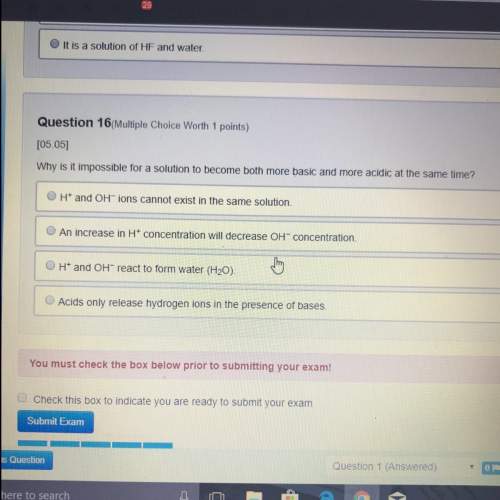
Chemistry, 28.04.2021 05:10 kyasnead8189
El sodio es un metal que reacciona vigorosamente con el agua, según la siguiente reacción: Na + H2O NaOH + H2 Una muestra de 9,85 g de Na se adiciono a un vaso que contenía 63,11 g de agua. Durante la reacción se observó burbujeo de hidrogeno. ¿Cuántos gramos de hidrogeno se produjeron? a. 0,22 c. 0,86 b. 0,428 d. 1,29

Answers: 1
Another question on Chemistry

Chemistry, 22.06.2019 01:30
In a spacecraft, the following reaction occurs: co2(g) + 2lioh(s) -> lico3(s) + h2o(i) (i attached picture of equation) how many liters of carbon dioxide will 4 moles of lithium hydroxide (lioh) absorb? (one mole of any gads occupies 22.4 l under certain conditions of temperature and pressure. assume those conditions for this equation.) 45l 6.0l 3.0l 34l
Answers: 1

Chemistry, 22.06.2019 08:30
What are the first three quantum numbers for the electrons located in subshell 2s?
Answers: 2

Chemistry, 22.06.2019 16:10
Amixture initially contains a, b, and c in the following concentrations: [a] = 0.300 m , [b] = 1.05 m , and [c] = 0.550 m . the following reaction occurs and equilibrium is established: a+2b⇌c at equilibrium, [a] = 0.140 m and [c] = 0.710 m . calculate the value of the equilibrium constant, kc.
Answers: 1

Chemistry, 22.06.2019 17:30
98 points you will be galileo perform the experiment to determine if objects with different mass fall at the same, or different, rates in the air and in a vacuum. before you conduct your experiment, you need to form a hypothesis. a hypothesis is a prediction of what you think will happen in the experiment. the hypothesis is a statement that describes “if” a certain set of circumstances are present “then” there will be a specific result that will occur. record your hypothesis here: record the results from step one of the experiment (dropping the objects in the air): first trial: second trial: third trial: record the results from step two of the experiment (dropping the objects in a vacuum): first trial: second trial: third trial: did the experiment support your hypothesis? using the data from your experiment, describe why you believe your hypothesis was either proven or disproven. what forces were acting on the objects dropped in the air? what force was acting on the objects dropped in the vacuum? part two: comparing forces choose two forces and compare and contrast these forces. you must provide two ways that they are alike and two ways that they are different. you may make a list, write in paragraph form, or make a chart. choose two forces and compare and contrast these forces. these must be different forces than used in the prior question. provide two ways that they are similar and two ways that they are different. you may make a list, write it out, or make a chart.
Answers: 3
You know the right answer?
El sodio es un metal que reacciona vigorosamente con el agua, según la siguiente reacción: Na + H2O...
Questions



Mathematics, 20.09.2020 09:01

English, 20.09.2020 09:01




Mathematics, 20.09.2020 09:01

Computers and Technology, 20.09.2020 09:01

Biology, 20.09.2020 09:01




Mathematics, 20.09.2020 09:01


Chemistry, 20.09.2020 09:01


Mathematics, 20.09.2020 09:01

Chemistry, 20.09.2020 09:01




